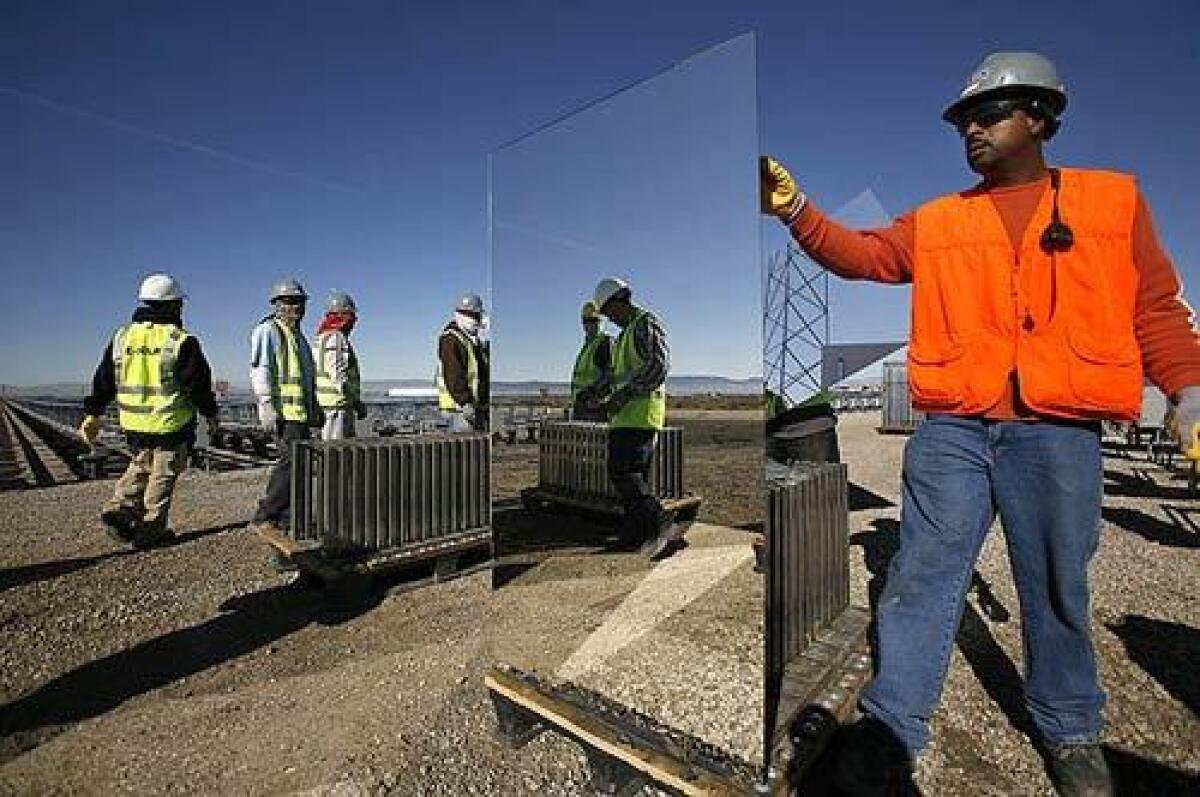Solar plant could be savior to struggling Lancaster

- Share via
They lined up for meatball sandwiches the other night outside the Lancaster Community Shelter, in the cold of the high desert. There was a man in a fedora who’d lost his house to the bank. A college student whose loans fell through. An older woman with curlers in her bag, who planned to do her hair after dinner.
Everyone had a story to tell, a cigarette to borrow, a friend to greet. But soon, the crowd hushed as a young mother and her boyfriend walked toward the door carrying 3-week-old twins. They had no money, nowhere to stay, they said. Between them, they’d applied for a dozen jobs -- she got all gussied up for her interview at Denny’s, even borrowed a pair of heels -- but they’d had a run of rotten luck, she said.
The buzz in the Antelope Valley these days is about a company called eSolar, which is putting the finishing touches on a thermal solar energy facility here -- 24,000 mirrors that glitter like diamonds when you approach on Avenue G. There are plans for several more facilities in the area, all larger, the company says.
Local officials are atwitter at the possibilities. Visitors and investors are expected from Saudi Arabia and Kuwait. A slew of jobs would be created; there were 225 people working last week on the Avenue G facility alone, most of them locals. Lancaster Mayor R. Rex Parris said the solar plants could be the catalyst to restoring the sort of “intellectual excitement” that existed when aerospace, still a vital industry here, was the only game in town -- when “if it went up, it came out of here,” he said.
“Now, we’re going to go a long way toward saving this world,” the mayor said. “Right here in Lancaster.”
It’s heady talk, and people are listening. Lancaster and the surrounding valley are suffering, even by the standards of a community that long ago acclimated to a boom-and-bust cycle. Many here are living on the edge, and some beyond, with tens of thousands more expected to arrive in coming years.
There is a sense that development cannot come fast enough, not with shops closing, one in five people living in poverty, high unemployment and the highest mortality rate in Los Angeles County. Not with so many houses falling into foreclosure that the city of Lancaster has gone into real estate -- buying and renovating empty homes to slow the decline of neighborhoods.
“It’s bad,” said William Turner, 21, who got a job installing eSolar mirrors through a temp agency. He is among those vying for one of the full-time positions the company will offer soon; competition will be fierce and many of those hired will be overqualified for their jobs, officials said.
“People around here are really hurting,” Turner said. “We need a change.”
ESolar operations and maintenance manager Bob Holsinger was the fourth of five siblings who grew up on an Illinois soybean farm, and he still looks the part, with broad, rounded shoulders and aircraft-carrier-sized boots.
When Holsinger was young, his father dispensed one piece of advice to the kids: “Last one out, turn out the lights.” It was meant, of course, to cut down on the power bill. But Holsinger always suspected it meant something else -- that whoever controlled the flow of electricity would be the last one standing, even if everything else went south. Today, after a 35-year career in energy, it turns out he might have been right.
California is the epicenter of U.S. solar technology; there are dozens of energy projects in the works. Few have generated as much anticipation as this one, if only because with 1,000 mirrors being installed each day, it is growing in stark contrast to the boarded-up storefronts and the brown, brittle lawns in front of abandoned houses.
The company uses the mirrors to focus the sun’s rays on an elevated target, which produces superheated steam that turns turbines to create power. The whole thing can be assembled easily, like an Erector Set for grown-ups. Workers can put it together using four wrenches.
The mirrors can be adjusted remotely from the company’s headquarters in Pasadena to ensure that they are capturing the sun. The mirrors can be fine-tuned; workers at a test site recently used the reflection to spell out the words “HAPPY BIRTHDAY BILL” for a colleague.
“It’s pretty slick,” Holsinger said.
When eSolar flips the switch, five megawatts of electricity will be sent into the grid, enough to power roughly 5,000 homes. A second facility, far larger, is expected north of Lancaster, and there are plans for several more in the area, enough to produce 500 megawatts, perhaps, in the next decade, the company says.
“We are not going to have a carbon footprint in 10 years. We just won’t have one,” said the mayor, a successful lawyer given to hyperbole, and to infectious passion.
It is an unlikely development in the Antelope Valley, which remains, despite its growth and increasing diversity, a strait-laced, conservative area. “Culturally, it is somewhat new,” said Barry S. Munz, vice president at Antelope Valley Engineering Inc., a contractor at the eSolar site.
But how important is it?
“We will turn flips for them,” Parris said. “And, quite frankly, I don’t turn flips for anybody.”
Back at the homeless shelter, it’s easy to see why.
Resident case manager Bobby Hampton said the shelter now serves up to 120 dinners each night, half again as many as when he started six years ago. Demand has been rising; this summer, he said, “business started booming.”
A striking number of clients lost their homes to the bank; others unwittingly rented rooms in abandoned houses taken over by unscrupulous squatters, only to get kicked out when they were discovered. The shelter is now full every night.
Waiting in line for a cot, Jerry Frazier, 50, a recovering heroin addict, said he received $199 for the month through the county-funded General Relief program. He spent $175 on a month’s supply of medication at a methadone clinic, leaving him $24 for the rest of the month. He’s been unable to find a job, he said; a former professional musician, he just pawned the last of his 32 guitars.
“This is a working country,” he said. “But there are no jobs. Not here.”
Once inside, those accepted for a bed were required to bathe, then routed into a line for dinner that snaked through the hall. A volunteer began to pray. “Hats off!” a security guard shouted.
In one corner, Jennifer Schmidt, 19, and her boyfriend, Treavon Henry, 20, ate their food in silence, their twin newborns, Kory and Kody, resting in car seats on the table.
Schmidt and Henry began dating in high school and could not have imagined what has happened since. Schmidt was on the pill but got pregnant anyway. Both lost their jobs. They don’t have enough money to get a market-rate apartment and have been on a waiting list for indigent housing since April.
They were living with her mother but were told to leave after Schmidt asked her not to smoke in front of the babies, Schmidt said. Then they moved in with his mother; she kicked them out, too, after Schmidt asked her not to cuss in front of the babies.
Exhausted, they slumped in Hampton’s cluttered office as he filled out a voucher for a room at a motel for one night. Then they carried the twins into the chilly night.
With no car -- they sold their Acura a few months back for $500 -- they would have to walk. Each carried a twin, until Schmidt’s arms couldn’t take any more. Henry picked up both twins and, holding them out to his side, struggled down the street toward the motel, past auto body shops and bail bonds offices.
“It feels like we’ve been walking forever,” Schmidt said.
Finally, they got to the motel. The marquee outside said: “KARAOKE, Sun-Wed.” By the time they walked into their room, Kody was crying. He was hungry, Schmidt said, and they were out of formula.
Gold is a Times staff writer.
More to Read
Sign up for Essential California
The most important California stories and recommendations in your inbox every morning.
You may occasionally receive promotional content from the Los Angeles Times.











